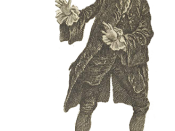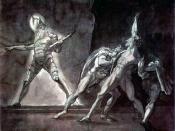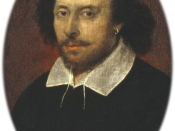In the tragic play Hamlet, the character Hamlet was undoubtedly one of William Shakespeare's greatest characterizations. The overall appeal Hamlet has to an audience or reader almost definitely stems from his many human weaknesses. The best known is indecisiveness, but his inconsistency is a more outstanding characteristic.
T.S. Eliot argued that Hamlet was an artistic failure, due to a basic weakness in the play. It was his contention that a playwright owes a duty to the audience to write a dialogue appropriate to characters as the have been developed in the drama. Eliot made the point in the "Closet Scene" (Act 3, Scene 4), when Hamlet confronts his mother, Queen Gertrude, in her bedchamber; his words demonstrate a bitter hostility and a vindictiveness for which the audience is totally unprepared. Since Eliot's charge against Hamlet is self-evidently valid, actors and directors attempting to stage Shakespeare's tragedy have struggled with the problem Eliot's essay highlighted, both prior to and after its publication.
The customary approach in the 20th and 21st century has been to imply, on Hamlet's part, a frustrated, incestuous love for his mother, which may justify his words although Shakespeare gives no background of his feelings towards his mother whatsoever. As a result this approach creates another inconsistency.
One can find a far greater inconsistency in the play than the inadequate preparation of the audience for Hamlet's lack of attitude toward his mother in the "Closet Scene". This inconsistency is Hamlet's lack of concern for his loss of the Kingdom of Denmark. It would appear to be an oversight on the part of the playwright, one of the keenest observers of human nature who ever lived. Shakespeare's genius was to show us the timeless aspects of our strengths and frailties through the characters in the plays. People tend to...


